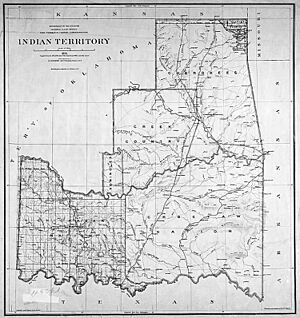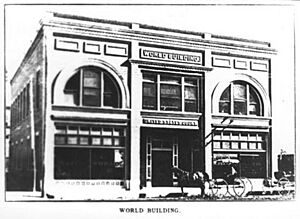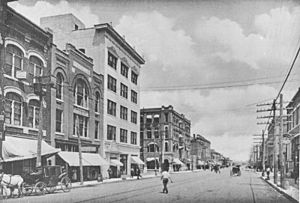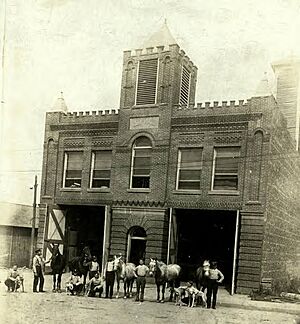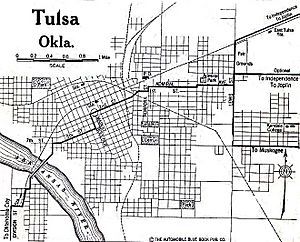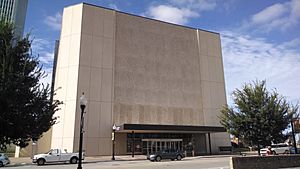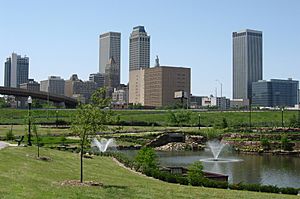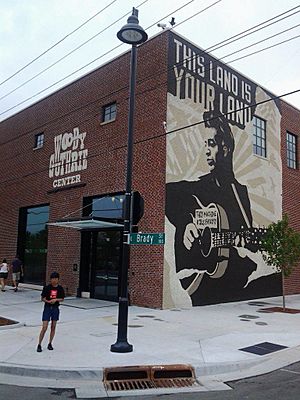Timeline of Tulsa, Oklahoma facts for kids
Tulsa, Oklahoma, has a long and interesting history! This timeline will take you through the most important moments, from its early days to the modern city it is today.
Early Days: Before the 1900s
First Visitors and Settlers
- 1540 – Hernando de Soto was the first European to visit the area that is now Tulsa.
- 1836 – The Creek people started settling the town of Tulasi. They moved here after being forced to leave their homes in the Southeastern United States.
- 1861 – Two battles of the American Civil War happened north of Tulsa: the Battle of Round Mountain and the Battle of Chusto-Talasah.
- March 25, 1879 – The first post office was set up at Perryman ranch.
Tulsa Starts to Grow
- 1882 –
- Atlantic & Pacific Railroad tracks were laid, connecting Tulsa to Vinita.
- T. J. (Jeff) Archer built the first store in downtown Tulsa.
- 1884 – A Presbyterian church started a mission school. This school later became Tulsa's first public school after the city was officially formed.
- 1886 – The first Methodist Episcopal Church was started in December in Tulsey Town.
- 1887 – The city of Tulsa was officially founded.
- 1893 – The Tulsa Review became the first newspaper published in Tulsa.
- 1895 – The New Era newspaper opened. It later changed its name to the Indian Republican and then to the Tulsa World.
Becoming an Official Town
- 1898 –
- Tulsa officially became an incorporated town on January 18.
- Edward E. Calkins became Tulsa's first mayor.
- The population was about 1,100 people.
- 1899 –
- The first church service was held at Holy Family Church.
- Robert H. Hall built Tulsa's first telephone system, serving 80 homes and businesses.
- R. N. Bynum became the second mayor.
- The Presbyterian mission school closed. Its building was bought and reopened as the first public school, starting the Tulsa Public Schools system.
- 1900 –
- The Commercial Club of Tulsa was formed to help local businesses.
- The population grew to 1,390.
- Lewis Poe became the third mayor.
The 20th Century: A City on the Rise
Early 1900s: The Oil Boom Begins
- 1901 –
- Oil was discovered at Red Fork, near Tulsa. This discovery started a huge oil boom, bringing many people and businesses to the city.
- George D. Blakey became the fourth mayor.
- 1902 – Tulsa was officially made a city.
- 1903 –
- The telephone system was sold to the Indian Territory Telephone Company.
- The original 3-story Brady Hotel was built.
- George Mowbray became the fifth mayor.
- 1904 –
- Tulsa added North Tulsa to its city limits.
- The first bridge across the Arkansas River was built in Tulsa.
- A pumping plant was built to bring water from the Arkansas River to homes.
- The Indian Territory Telephone Company was bought by Pioneer Company.
- An accidental explosion destroyed the Archer store, killing a customer and seriously injuring Jeff Archer.
- H. R. Cline became the sixth mayor.
- 1905 –
- The Tulsa World newspaper began publishing.
- More oil was discovered at Glenn Pool near Tulsa.
- The first two public schools were built.
- Charles LaFayette Reeder became the seventh mayor.
- 1906 –
- Tulsa Hospital opened (it closed after World War I).
- A trolley system began operating in the city.
- Tulsa High School was built.
- Oklahoma Natural Gas Company, now called OneOK, was founded.
- John O. Mitchell became the eighth mayor.
- 1907 –
- Tulsa became part of the new U.S. state of Oklahoma and the main city of the newly formed Tulsa County.
- Henry Kendall College moved from Muskogee to Tulsa.
- The population reached 7,298.
- William E. Rohde became the ninth mayor.
- 1908 –
- Tulsa adopted a commission form of government.
- Orcutt Lake and Amusement Park, a private park, opened as Tulsa's first playground.
- 1909 –
- West Tulsa became part of Tulsa.
- Tulsa bought land that would become Woodward Park.
- John O. Mitchell returned to office and became the tenth mayor.
- 1910 –
- The Tulsa County Court House was built.
- The population grew to 18,182.
- Exchange National Bank was founded after another bank failed.
- Texaco built the first oil refinery in West Tulsa.
- The Oil & Gas Journal, a magazine for the oil industry, set up its main office in Tulsa.
- The city's area was 3.5 square miles.
- The Hotel Brady annex and Tulsa Hotel were built.
- Loyal J. Martin became the eleventh mayor.
Growth and Development in the 1910s and 1920s
- 1912 – Frank M. Wooden became the twelfth mayor.
- 1913 –
- Booker T. Washington High School was established.
- Joshua Cosden built a second oil refinery in West Tulsa.
- 1914 –
- Tulsa Convention Hall was built.
- Holy Family Cathedral was dedicated.
- The Temple Israel congregation was founded.
- 1915 –
- Oklahoma Hospital was established.
- The Chamber of Commerce became very active.
- Grace M.E. Church was built at 3rd and Trenton Ave., now known as The Church Studio.
- 1916 –
- A Carnegie library opened, which was the start of the Tulsa Public Library system.
- John H. Simmons became the thirteenth mayor.
- 1917 –
- Orcutt Lake Amusement Park closed and was turned into the Swan Lake neighborhood. The lake itself was given to the City of Tulsa as a public park.
- Construction of Tulsa Central High School was completed.
- The Tulsa Outrage occurred.
- 1918 –
- Morningside Hospital opened.
- The Cosden Building was built, considered the city's first "skyscraper."
- C. H. Hubbard became the fourteenth mayor.
- 1920 –
- Henry Kendall College became the University of Tulsa.
- The Tulsa Tribune newspaper began publishing.
- The population reached 72,075.
- T. D. Evans became the fifteenth mayor.
- 1921 –
- May 31 – June 1: The Tulsa race massacre caused terrible damage to the Greenwood area.
- All Souls Unitarian Church was founded.
- 1922 –
- Tulsa Little Theater was founded.
- The Atlas Life Building was constructed.
- Herman Frederick Newblock became the sixteenth mayor.
- 1923 –
- The first International Petroleum Exposition was held, showcasing the oil industry.
- A major flood of the Arkansas River damaged Tulsa's water plant, leading to its relocation.
- Oil baron Earl P. and his wife Mary Harwell completed their English Tudor mansion, now known as Harwelden Mansion.
- 1924 –
- The Spavinaw Dam was built to provide water to Tulsa.
- The Tulsa Community Fund was established.
- St. Johns Hospital opened.
- Southwestern Bell Telephone Company built its Main Dial System Building.
- 1925 – The Mayo Hotel was built.
- 1926 –
- KVOO radio began broadcasting.
- The Tulsa State Fair grounds were put into use.
- 1927 –
- 1928 –
- Tulsa Coliseum was built.
- Carbondale became part of Tulsa.
- Tulsa Municipal Airport was dedicated.
- Spartan Aircraft Company began business.
- Spartan School of Aeronautics was established.
- The Philtower Building was constructed.
- Dan W. Patton became the seventeenth mayor.
- 1929 –
- The Tulsa Oilers ice hockey team played for the grand opening of the Tulsa Coliseum on January 1.
- Boston Avenue Methodist Church and the National Bank of Tulsa Building were constructed.
- The Mohawk Park Waterworks Plant was completed.
- Tulsa officially added Carbondale.
- The Public Service Company Building was completed.
The Mid-20th Century: 1930s and 1940s
- 1930 –
- Cain's Dance Academy opened.
- The population reached 141,258.
- George L. Watkins became the eighteenth mayor.
- 1931 –
- Union Depot opened.
- The Philcade Building was constructed.
- The first All Souls Unitarian Church building was completed.
- 1932 –
- The Tulsa Fairgrounds Pavilion (an arena) was built.
- Waite Phillips donated his home to become the Philbrook Art Museum.
- Herman Frederick Newblock returned to office and became the nineteenth mayor.
- 1934 –
- The National Conference of Christians and Jews Tulsa chapter was founded.
- T. A. Penney became the twentieth mayor.
- 1935 – The Brady Hotel was destroyed by fire.
- 1938 –
- KOME radio began broadcasting.
- Webster High School opened.
- 1939 –
- Morningside Hospital was reorganized and renamed Hillcrest Hospital.
- Philbrook Art Center opened.
- Will Rogers High School was built.
- 1940 –
- The population was 142,157.
- Clarence H. Veale became the twenty-first mayor.
- 1941 – The Air Force built a bomber plant at Tulsa Airport. Douglas Aircraft Co. built bombers until World War II ended in 1945. Boeing later used the plant to build B-47s from 1950 to 1953.
- 1943 – Oklahoma Hospital became Oklahoma Osteopathic Hospital.
- 1944 – Olney F. Flynn became the twenty-second mayor.
- 1946 –
- American Airlines opened an aircraft maintenance facility at Tulsa Airport.
- Lee Price became the twenty-third mayor.
- 1948 –
- Tulsa Opera and Tulsa Philharmonic were founded.
- Roy M. Lundy became the twenty-fourth mayor.
- 1949 –
- Dawson became part of the city.
- KOTV began broadcasting television.
Late 20th Century: 1950s to 1990s
- 1950 – The population reached 182,740.
- 1951 – Bell's Amusement Park opened.
- 1952 –
- Lake Eucha and a second pipeline were built to bring more water to Tulsa from Lake Spavinaw.
- Tulsa Coliseum was destroyed by fire after being hit by lightning on September 27.
- 1953 –
- The Golden Driller statue was created for the International Petroleum Exposition.
- The Tulsa Metropolitan Area Planning Commission was established.
- 1954 – KTUL-TV and KVOO-TV (television stations) began broadcasting.
- 1956 –
- Highland Park became part of Tulsa.
- Tulsa Ballet and Tulsa Baptist Association were founded.
- 1957 –
- All Souls Unitarian Church moved from downtown to Brookside.
- June: The Tulsarama pageant was held.
- 1958 –
- Apache Drive-In cinema opened.
- The Gilcrease Foundation gave Gilcrease Museum to the city.
- 1959 – A black family's home in a mostly white neighborhood in north Tulsa was bombed during the Civil rights movement.
- 1960 –
- Saint Francis Hospital opened.
- The city's area was 50 square miles.
- The population reached 261,685.
- 1961 – A new airport terminal opened.
- 1963 – Tulsa Youth Symphony was founded.
- 1964 – Tulsa Convention Center opened.
- 1965 –
- Oral Roberts University was established.
- The Tulsa City-County Library Central Library opened.
- 1966 –
- The city's area expanded.
- The Tulsa Expo Center was built, and the Golden Driller statue was permanently installed there.
- James M. Hewgley, Jr. became mayor.
- 1967 –
- The Prayer Tower and Fourth National Bank of Tulsa were built.
- Union Depot was no longer used after passenger train service stopped.
- 1970 –
- Tulsa Junior College was established.
- Robert J. LaFortune became mayor.
- The population reached 331,638.
- 1971 – The Tulsa Port of Catoosa opened for shipping via the McClellan-Kerr Arkansas River Navigation System.
- 1972 –
- The Roman Catholic Diocese of Tulsa was established.
- The city's area was 175.71 square miles.
- Leon Russell returned to Oklahoma and turned an old church into The Church Studio, a recording studio and office for Shelter Records.
- 1973 – First National BanCorporation Tower was built.
- 1974 –
- The United Way of Tulsa Area became active.
- F3 tornadoes and flooding caused $30,000,000 in damage, the costliest natural disaster in the city's history at that time.
- 1975 –
- National Bank of Tulsa was renamed Bank of Oklahoma (BOK).
- Westhope was added to the National Register of Historic Places (NRHP).
- Tulsa Municipal Building was added to the NRHP.
- Williams Brothers Tower (now named BOK Tower) was built.
- 1976 –
- A Memorial Day flood caused major damage along Mingo, Joe, and Haikey creeks.
- Woodland Hills Mall opened for business.
- Tulsa Central High School moved to a new location. The old school building was leased to Public Service Company of Oklahoma for their new headquarters.
- 1977 – The Tulsa Performing Arts Center opened.
- 1978 –
- Tulsa Signature Symphony was founded.
- Jim Inhofe became mayor.
- Boston Avenue Methodist Church was added to the NRHP.
- Philbrook Museum of Art was added to the NRHP.
- William G. Skelly House was added to the NRHP.
- 1979 –
- Convention Hall (Brady Theater) was added to the NRHP.
- McFarlin Building was added to the NRHP.
- Philtower was added to the NRHP.
- Pierce Block was added to the NRHP.
- The last International Petroleum Exposition was held.
- Mike Synar became a U.S. representative for Oklahoma.
- 1980 –
- Tulsa Oklahomans for Human Rights group was formed.
- Brady Heights Historic District was added to the NRHP.
- Mayo Hotel was added to the NRHP.
- The population reached 360,919.
- 1981 –
- City of Faith Medical and Research Center opened.
- Tulsa Community Food Bank and Heller Theatre were founded.
- 1982 –
- Gillette Historic District was added to the NRHP.
- Holy Family Cathedral, Rectory and School were added to the NRHP.
- Tulsa Pride events began.
- 1983 – Swan Lake Neighborhood Association and Gilbert and Sullivan Society of Tulsa were founded.
- 1984 –
- Mid-Continent Tower was built.
- Oklahoma Natural Gas Company Building was added to the NRHP.
- Public Service of Oklahoma Building was added to the NRHP.
- 1986 – Philcade Building was added to the NRHP.
- 1987 –
- The Chili Bowl midget car race began.
- Jim Inhofe became a U.S. representative for Oklahoma.
- 1988 – Tulsa Preservation Commission and Oklahoma Jazz Hall of Fame were established.
- 1989 –
- Osage Expressway opened.
- Tulsa adopted a mayor–council form of government.
- 1990 –
- Southwest Tulsa Chamber of Commerce was formed.
- The population reached 367,302.
- 1991 – Urban Tulsa Weekly newspaper began publishing.
- 1992 –
- Tulsa received an award from FEMA for its flood management program.
- The Tulsa Tribune newspaper closed.
- Susan Savage became the first woman to serve as mayor of Tulsa.
- 1994 – Tulsa Club left its building, which remained mostly empty for almost 20 years.
- 1996 – Camille's Sidewalk Cafe opened for business.
- 1997 – Conestoga science fiction convention began.
- 1998 –
- Tulsa Community Foundation was established.
- Tulsa Air and Space Museum was established.
- Swan Lake Historic District was added to the NRHP.
- 1999 –
- The city's website went online.
- Eleventh Street Arkansas River Bridge was added to the NRHP.
- Hindu Temple of Greater Tulsa was founded.
- 2000 – The population was 393,049; the greater Tulsa area population was 859,532.
The 21st Century: Modern Tulsa
- 2001 – White City Historic District was added to the NRHP.
- 2002 –
- Diversafest began.
- Yorktown Historic District was added to the NRHP.
- 2003 – Cain's Ballroom was added to the NRHP.
- 2004 – The 11th Street Bridge was renamed the Cyrus Avery Route 66 Memorial Bridge.
- 2005 –
- Tulsa Symphony Orchestra was formed.
- The Oklahoma Center for Community and Justice set up its main office in Tulsa.
- 2006 – Bell's Amusement Park closed.
- 2007 –
- The Union Depot building was converted to house the Oklahoma Jazz Hall of Fame.
- Will Rogers High School was added to the NRHP.
- Buena Vista Park Historic District was added to the NRHP.
- Ranch Acres Historic District was added to the NRHP.
- 2008 –
- The University of Tulsa was chosen to manage the Gilcrease Museum.
- Tokyo, OK (formerly Tokyo in Tulsa) anime convention began.
- BOK Center stadium opened.
- Mt. Zion Baptist Church was added to the NRHP.
- The Cyrus Avery Route 66 Memorial Plaza opened.
- 2009 –
- The old Temple Israel accidentally burned down.
- Tulsa Botanic Garden opened to the public.
- Dewey F. Bartlett, Jr. became mayor.
- Atlas Life Building was added to the NRHP.
- 2010 –
- This Land Press began publishing.
- The population was 391,906; the greater Tulsa area population was 937,478.
- The city's area was 196.75 square miles.
- Oil Capital Historic District was created on December 10.
- Brady Historic District was added to the NRHP.
- 2012 – Oklahoma Defenders football team became active.
- 2013 –
- Tulsa Convention Center was renamed Cox Business Center.
- The Center of the Universe Festival (a music festival) was held.
- The Woody Guthrie Center opened as a museum and archive for the artist.
- Jim Bridenstine became a U.S. representative for Oklahoma.
- Construction began on Phase 1 of Cousins Park.
- 2014 –
- Woodward Park and Gardens Historic District was established.
- The Helmerich Center for American Research at Gilcrease Museum was completed.
- 2015 –
- James Pepper Henry became director of Gilcrease Museum on March 1.
- Frontier news began publishing.
- Oklahoma Defenders football team stopped operating.
- 2016 –
- The Vision 2025 Tax plan was approved by voters to fund major projects.
- The former Public Service of Oklahoma (PSO) headquarters was renamed Art Deco Lofts and Apartments, with new residents moving in starting July.
- 2017 –
- James Pepper Henry resigned as director of Gilcrease Museum to become Director of the American Indian Cultural Center & Museum in Oklahoma City.
- An EF-2 Tornado struck southeast Tulsa after midnight on August 5–6, causing major property damage, especially to Promenade Mall and the Remington Tower office building. No deaths occurred, but 32 people were sent to hospitals.
- 2018 – "Gathering Place" held its grand opening to the public on September 8.
- 2019 –
- Tulsa Club Hotel (formerly known as the Tulsa Club Building) opened for business on April 18.
- High water along the Arkansas River caused serious flooding in the Tulsa Metropolitan area, forcing shutdowns of Gathering Place and the Tulsa Port of Catoosa.
- 2020 –
- The U.S. Census population was 413,066.
- Wendell Franklin was appointed as Chief of Police on February 1.
- 2021 – Former congressman Brad Carson became president of the University of Tulsa on July 1.
- 2022 –
- Discovery Lab at Gathering Place held its grand opening on January 24.
- The Warren Clinic shooting occurred.
More About Tulsa
- List of mayors of Tulsa, Oklahoma
- National Register of Historic Places listings in Tulsa County, Oklahoma
- Timelines of other cities in Oklahoma: Norman, Oklahoma City

All content from Kiddle encyclopedia articles (including the article images and facts) can be freely used under Attribution-ShareAlike license, unless stated otherwise. Cite this article:
Timeline of Tulsa, Oklahoma Facts for Kids. Kiddle Encyclopedia.

